Add a New Audit
In Trial Interactive, before creating an Audit Profile, it may be helpful to understand the various roles that are assigned to users as a part of creating the audit:
- Auditor: Users assigned to this role are responsible for reviewing documents and assigning them a status of passed or failed. Any level of user can be assigned to this role.
- Audit Manager: Users assigned to this role can see audit results, create an audit export, reassign documents to other auditors, release audit findings from review, and make changes to the audit profile. Only editors and higher-level users may be assigned to this role.
- Audit Responder: Users assigned to this role are responsible for taking action to rectify audit findings generated by the auditors during their review of the documents. Only editors and higher-level users can be assigned to this role.
The process for creating a new audit profile is discussed below:
Note: Prior to beginning this process, it is crucial that you ensure that all applicable Quality Review Statuses should have already been created.
- Navigate to the Quality Review Settings area of the Quality Review module.
- Click the ‘Add’ button displayed in the top menu
bar above the grid.
- This will open the Create Audit Profile window.
Figure 1. Figure 9: Create Audit Profile 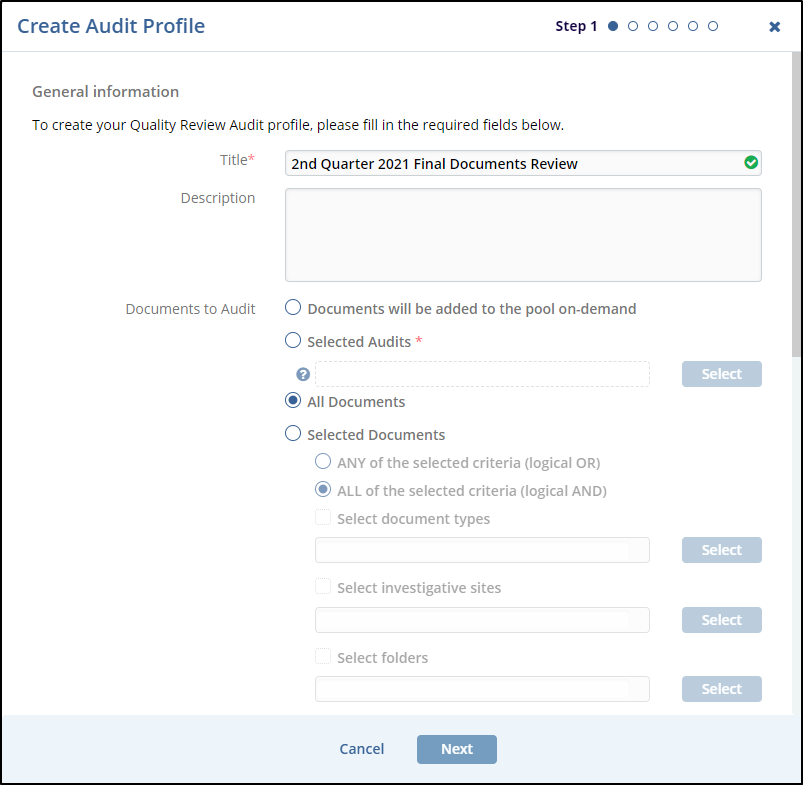
- This will open the Create Audit Profile window.
- Enter a Title for the audit profile.
- It is generally best to be as specific as possible here. For example: 2nd Quarter 2021 Final Documents Review.
- The Description field is not required but it is highly
recommended as it serves as a mission statement of sorts for the
audit and will assist in choosing the correct audit settings in the
remainder of the fields.
- For example: “This audit will review a random 20% of all documents that were published to the eTMF during the 2nd quarter of 2021.”
- The ‘Documents to Audit’ area has several options
to choose from:
- Documents will be added to the pool on-demand: This option will create a blank audit with no documents in it. Editor, manager, and administrator users can then add documents to the audit manually via the Documents Cart.
- Selected Audits: This option indicates that the audit will be reviewing the work done in a prior audit or set of audits. If you select this option, you will be asked to specify which audit and which auditor(s) you wish to review.
- Click the Select button to open the ‘Select Audit’
popup window.
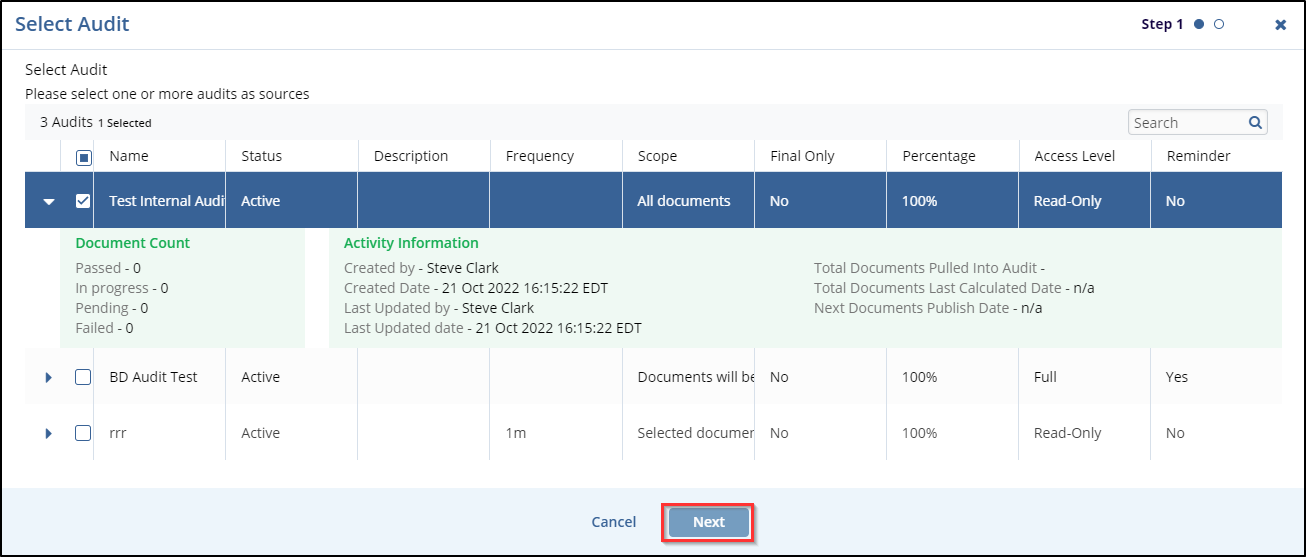
- Click the Next button to select the auditors in the next step.
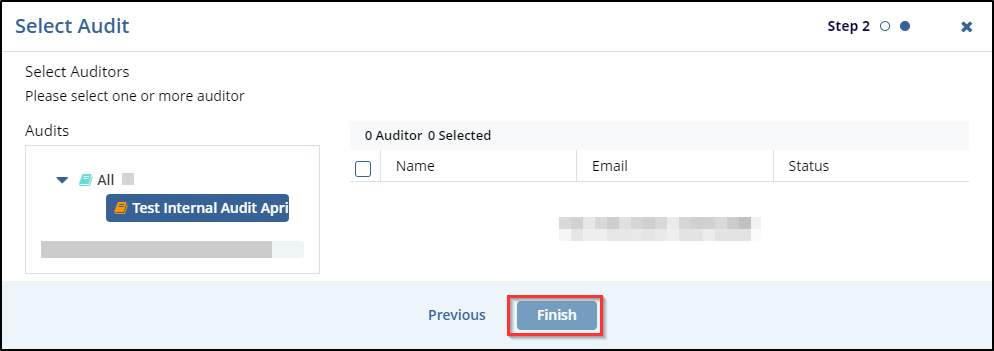
- All Documents: This option will cause the system to gather all documents which meet the criteria chosen below.
-
Selected Documents: This option allows the user to
specify the criteria which the room will use in gathering documents
for review.
- The user will first need to specify whether the room should take in to account ANY or ALL of the criteria specified.
- Select any one OR all the checkboxes for – Select Document Types, Investigative Sites, or Folders.
- Click the ‘Select’ button to choose the appropriate and required document type, investigative site and folder.
- The Audit Scope is only applicable to audits which are
reviewing documents from a specific timeframe.
- In the example from above (2nd Quarter 2021 Final Documents Review), the user would specify the beginning and end dates for the 2nd Quarter of 2021.
- The ‘Use Submitted Dates’ and ‘Final’
radio buttons are asking the user to specify which date should be
used when determining whether or not the document falls into the
Audit Scope designated in step 6.
- Use Submitted Dates: The date that the document was submitted to the room.
- Final: The date that the document was made ‘Final’ and published to the index.
- Indicate whether or not the system should include documents which were already included as a part of another audit.
- Indicate whether the system should include only documents which
are in a ‘Final’ status.
- If this option is not checked, it is possible that a document
may go through the QC Workflow and the Quality Review Audit at the
same time. This may cause some confusion and is not recommended.
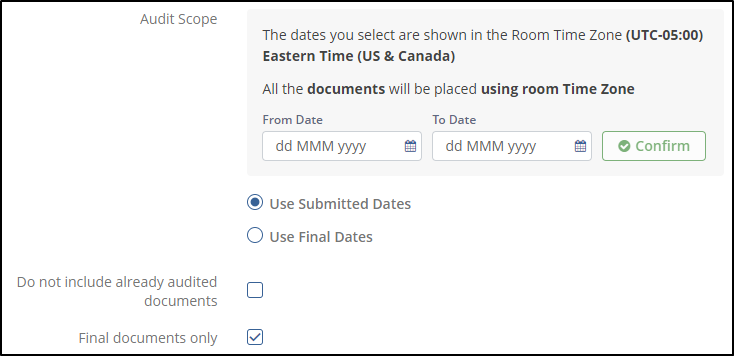
- If this option is not checked, it is possible that a document
may go through the QC Workflow and the Quality Review Audit at the
same time. This may cause some confusion and is not recommended.
- Sometimes, when the Audit Responder is addressing an Audit
Finding, a document’s metadata may be updated. The ‘Add
modified documents back into the audit pool’ option tells the
system that, if any of the following metadata fields were updated
as a part of the correction, the document should be re-added to the
audit for another review.
- Index
- Category
- Document Type
- Investigative Site
- Document Date

- The ‘Percentage of new documents’ tells the system
that, whenever it gathers documents matching the criteria above, it
needs to take a random sampling matching the designated percentage.

- The ‘Update Interval/Frequency’ field is for use in ongoing audits which will need to be updated at regular intervals. The system will go out and gather new documents matching the specified criteria at the indicated interval.
- Indicate the auditor access level.
- View Only, no download: This restricts the auditor to viewing documents.
- Full Access: This allows the auditor to download or modify documents based on their user access level rights. This is most commonly applied to internal audits.
- Indicate whether the auditors should have access to the
‘Contains PHI’ function.
- This function allows an auditor who discovers PHI in the room to immediately delete the attached file. This will move the file record (metadata only) to the Audit Responder so that they can upload a redacted version of the document.
- There are two types of audit notification that can be sent. Indicate whether or not the room should send audit notifications.
- Click the ‘Next’ button displayed at the bottom of
the popup window.

- The next step is to assign the users who will be Auditors in the audit.
- Click the ‘Add’ button.
- This opens the ‘Add Users and Groups’ window.
- Move any applicable users and/or groups to the right panel by clicking and dragging, double clicking, or by pressing the + sign that appears at the right side of the user’s line.
- Click the Add button displayed at the bottom of the popup window.
- If multiple auditors have been added, the ‘Configure
Content’ option may be used. It is optional.
- This option is most useful when you have chosen specific criteria such as document types or investigative sites and you would like a specific auditor to review a specific document type or all documents associated with a specific site.
- Select the auditor and click the ‘Configure Content’ button displayed in the top right corner.
- Choose which criteria will be used in assigning documents to
this auditor:
- Document Types
- Investigative Sites
- Folders
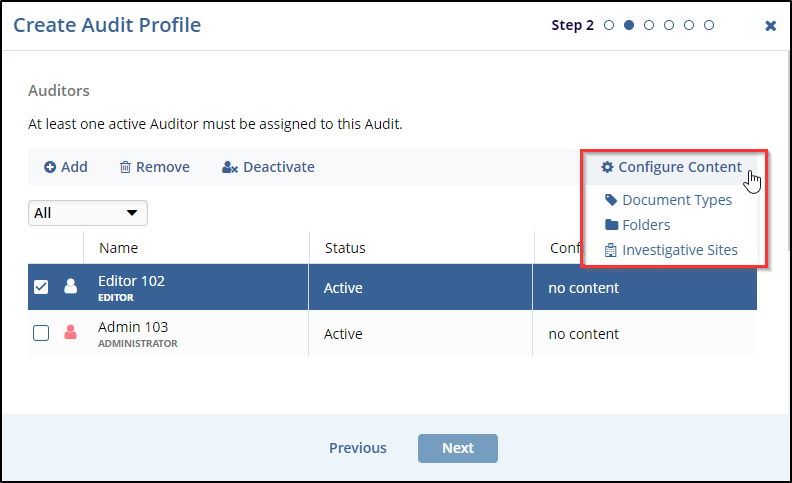
- Once selected, another window will open in which you will be able to specify which document types, sites, or folders apply to the specified user.
- When you are done adding auditors and, if necessary, configuring content, click the ‘Next’ button.
- The next step is to assign the users who will be Audit Managers in the audit.
- Click the ‘Add’ button displayed at the top left
corner of the popup window.
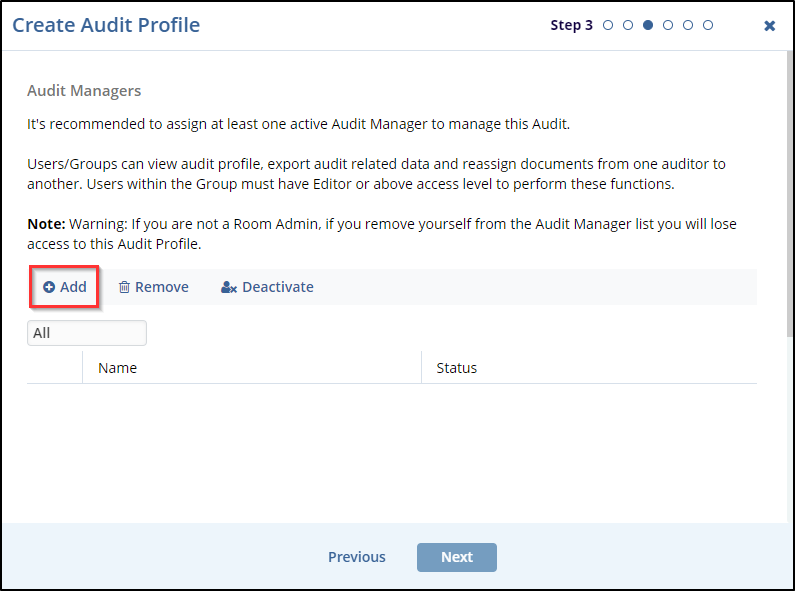
- This will open the ‘Add Users and Groups’ window.
- Move any applicable users and/or groups to the right panel by clicking and dragging, double clicking, or by pressing the + sign that appears at the right side of the user’s line.
- Click the ‘Next’ button when done.
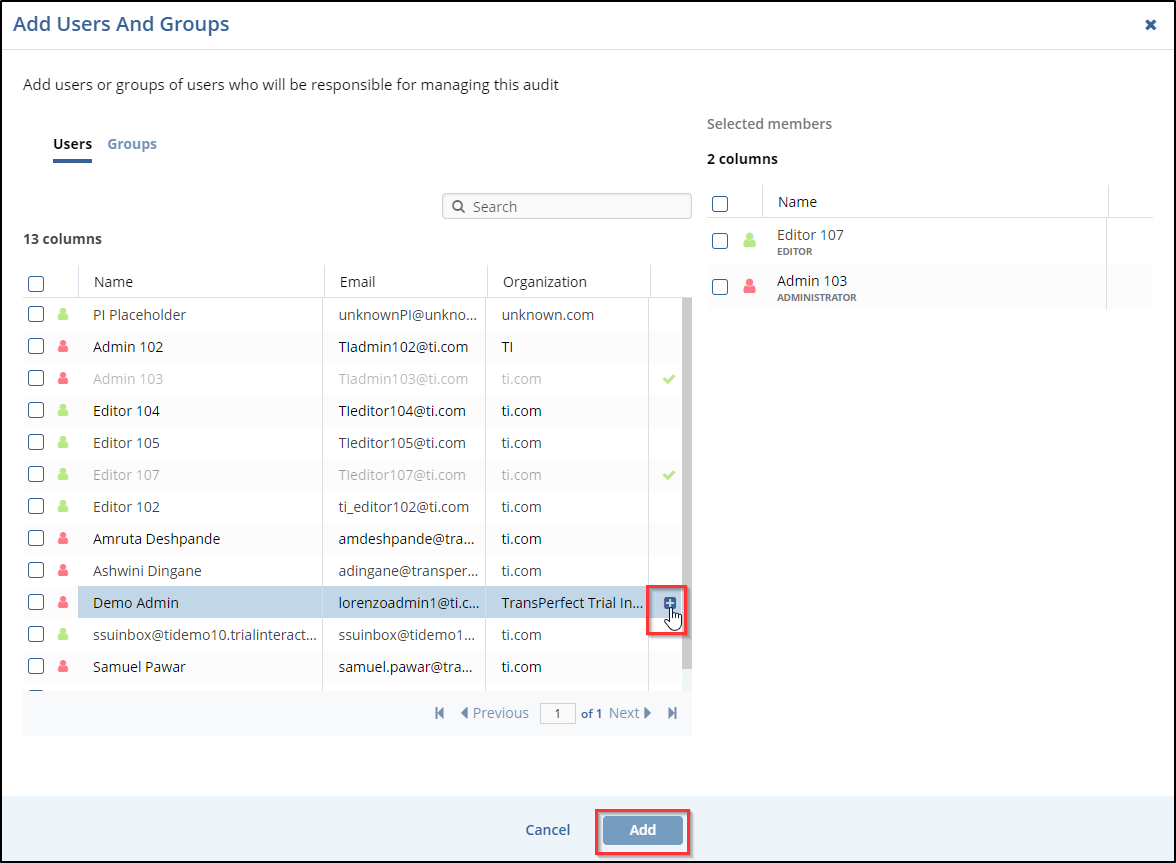
- The selected Audit Managers are reflected in the grid.
- The next step is to assign the users who will be Audit
Responders in the audit.
Note: The users cannot be the same for Audit Responders as those who are added as Auditor Managers.
- Click the ‘Add’ button.
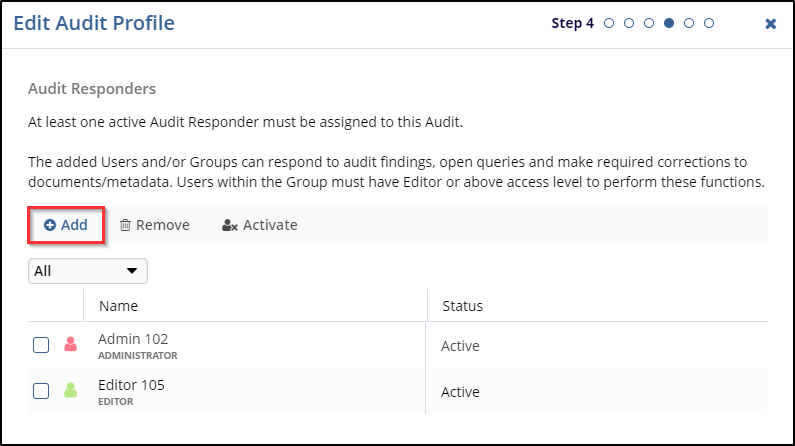
- This will open the ‘Add Users and Groups’ window.
- Move any applicable users and/or groups to the right panel by
clicking and dragging, double clicking, or by pressing the + sign
that appears at the right side of the user’s line.
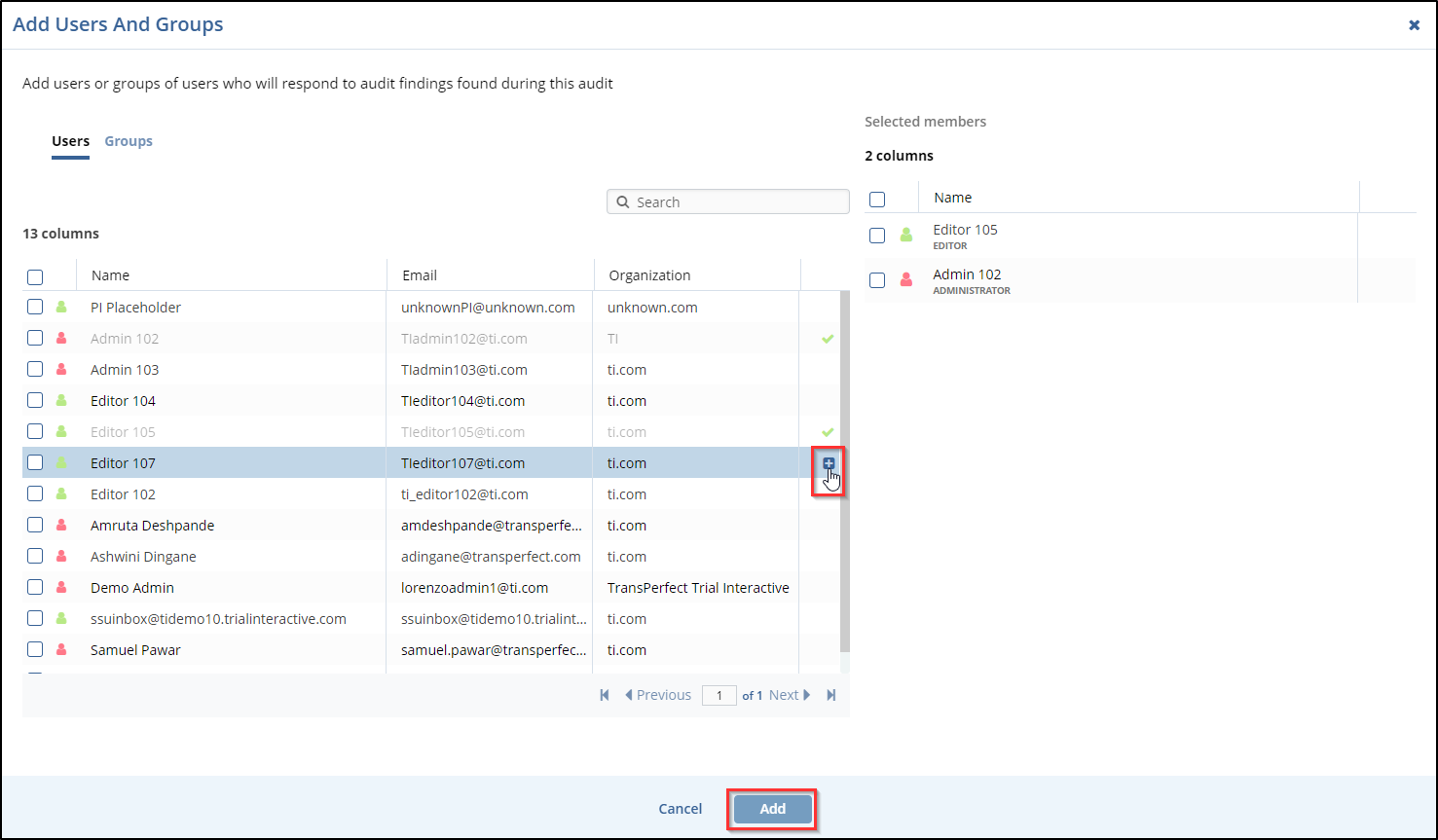
- Click the ‘Next’ button when done.
- In the next window, you will be required to choose the document
statuses for use in the audit.
- These must have been created prior to beginning the audit.
- You will be required to include at least one status for each of
the basic 5 system statuses:
- Passed
- Failed
- Pending
- In Progress
- Excluded
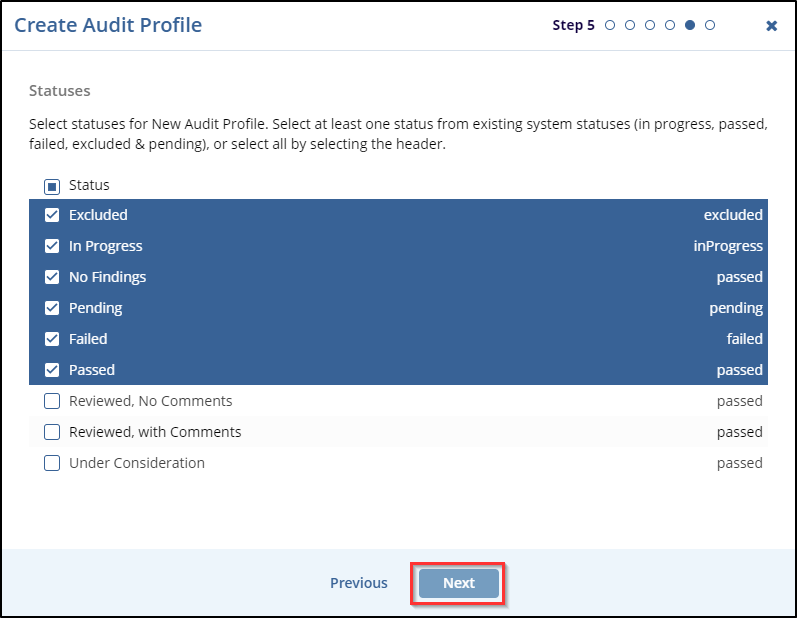
- Click the ‘Next’ button when done.
- The final screen indicates if there are any errors detected.
- The most common of these would be if you had a user added as both an Audit Manager and an Audit Responder.
- If there are any errors, use the section link to go back and
correct the error.
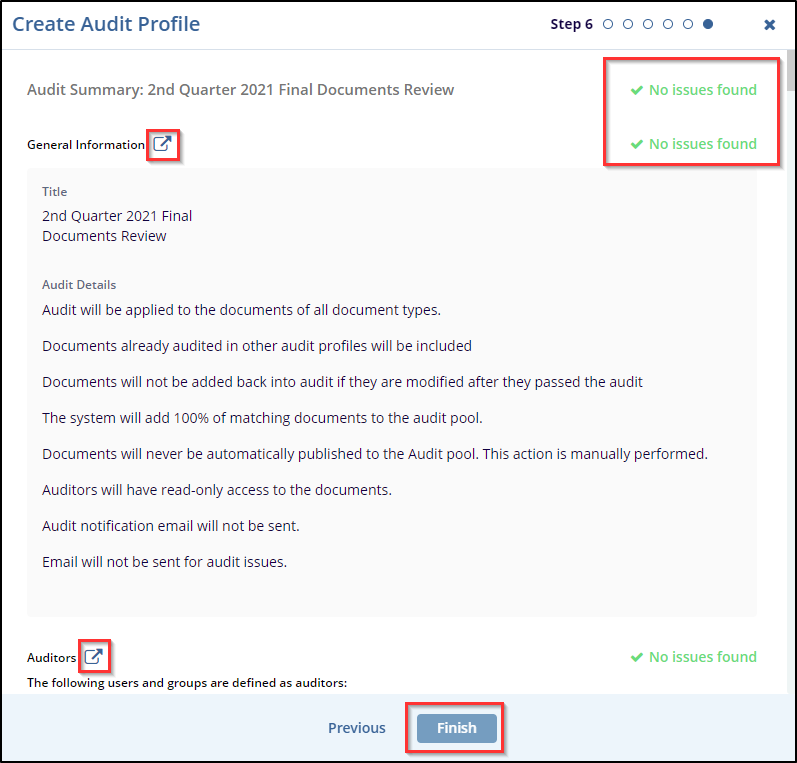
- When you are done, click the ‘Finish’ button.
- A window will open asking you if you want to activate the
audit.
- If you press ‘No’ the window will close and the audit will be added to the list in an ‘Inactive’ status.
- If you press ‘Yes’ the window will close and the
audit will be added to the list in an ‘Active’ status.

- The Document Quality Review Settings displays the newly added audit profile in the grid.
